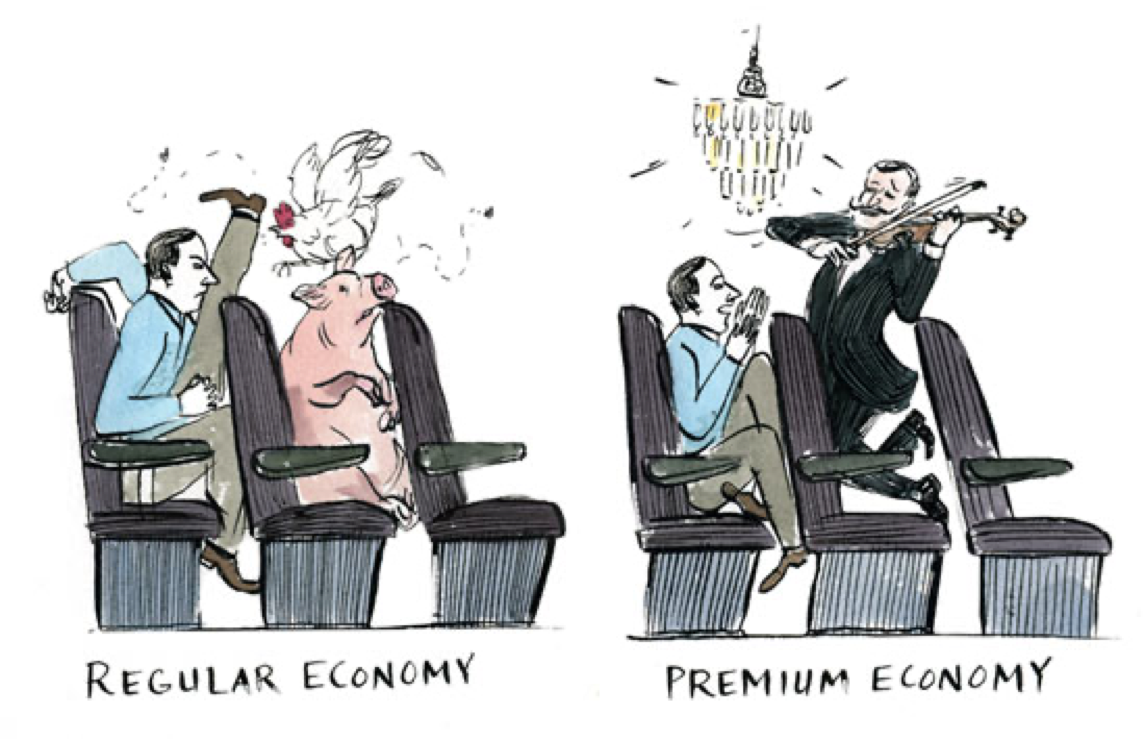Here are the major differences among economy, premium economy, and economy plus.

The decisions that come with flying can be overwhelming: Do you want to book an economy ticket and bank on an upgrade, thanks to your frequent-flier status? Would you prefer to cut costs and opt for basic economy, even if that means compromising on what you can pack in a carry-on suitcase?
Understanding the differences in seating levels can help you make an informed decision about which ticket to book. Seating classifications that come after first and business class run the gamut, from basic to premium economy, with the two options after business class—premium economy and economy plus—often the hardest for travelers to distinguish between.
Below are the differences among premium economy, economy plus, and economy, including the usual price differential, which airlines offer which seating classifications, and when it’s worth the cost.
What is premium economy?
Let’s start from the top. Premium economy fits between coach and business class, both price-wise and in terms of placement on the aircraft. A seat in premium economy—directly between the main and business class cabins—is measurably more expensive than an economy ticket (often double the price). But according to Skyscanner, it’s still 65% less expensive than business class. Skyscanner also reports premium economy offers, on average, five to seven inches more legroom than economy, typically with “wider seats and more space to recline.”
It isn’t just the seats and overall space that are more, well, premium than those in economy. It’s the extras, too. Premium economy offers upgraded meals, amenity kits, and priority boarding. Those flying in premium economy often won’t have to pay fees on checked baggage, and accrue airline miles at a different rate than if they were traveling on a coach ticket.
American Airlines offers premium economy, as does Air Canada and Singapore Airlines, among others. Other airlines offer their own take on premium economy, offering similar levels of amenities but with a different name. For example, Delta’s premium economy class is called Premium Select (available only on certain international flights). United’s is called Premium Plus, Virgin Atlantic has Premium, and on British Airways, it’s World Traveller Plus.
What is economy plus?
If premium economy is a hybrid of business class and economy, where does that leave economy plus? Economy plus is not as luxurious as premium economy, though it is more affordable. Rather than being segregated in a separate section, economy plus seats are located in the main cabin. When flying economy plus, while you’re still sitting in the coach cabin, you do have a better seat—there’s more legroom, and on some airlines, the seats are actually more plush, wider, or newer than those in the rest of coach. Beyond that, you’ll be at the front of the main cabin and typically benefit from priority boarding and potentially a better beverage or meal service (depending on the airline).
Many airlines offer an economy plus-type ticket, but call it something else. Delta has Comfort+ (you receive the same amenity kits as do first class passengers), JetBlue has Even More Space (seven additional inches of legroom), and American Airlines offers Main Cabin Extra (the airline says upgrades start at $20). On United, it’s called economy plus, and you can even get a subscription.
What is the cost and upgrade potential for premium economy and economy plus?
Is premium economy or economy plus worth the price bump? It depends on the length of your flight and personal preference. For a cross-country flight (JFK to LAX, for example), you’ll usually pay an additional $100 to $300 for an economy plus-type ticket on Delta or JetBlue. For a premium economy ticket, you’ll shell out at least $300 over a regular coach ticket, if not more. (Paying double the price of an economy ticket for premium economy, especially when flying abroad, is fairly standard.)
That said, if you have any sort of airline status, you may unlock upgrades that could get you into an economy plus or premium economy seat at no charge. For example, if you have the lowest status tier on Delta, Silver Medallion, you are eligible for complimentary upgrades to Comfort+ and first class on international flights, space permitting. Meanwhile, American’s lowest status tier (Gold) qualifies you for an upgrade from the main cabin to the “next class of service,” either automatically (space permitting) or with a 500-mile upgrade voucher.
Where does economy fit into this?
“Economy” is the standard, main cabin fare. Whether or not you get meal service depends on the airline and your particular flight. Unless you have an airline credit card or status with the carrier, you are generally permitted one carry-on plus a personal item, and will have to pay for checked bags. You’ll also get standard seating with about 30 to 31 inches of legroom, though it varies by airline and aircraft.
Twist’s Take: Consider the differences among economy, premium economy, and economy plus to choose the right seat for your comfort level and price point.
